[ad_1]
Facebook Insights gives tons of metrics needed to monitor your campaign performance and optimize the marketing on the platform further.
But sometimes, for new businesses and startups, it is hard to get their head wrapped around the plethora of Facebook metrics available and pick out the key indicators needed to better evaluate their performance.
Don’t worry. This blog will cover every key Facebook metric that you should track and why it is crucial for your overall Facebook marketing strategy.
According to statistics, 1.6 billion people connected with a small business on Facebook, which is enough evidence of the platform’s affinity for SMBs and startups.
Now, calling shots on the platform without assessing Facebook insights could be a total waste of such a powerful marketing channel.
When using Facebook to market your business, it is crucial to have a data-driven strategy derived from the key metrics that align with your marketing goals.
If not, then let’s see the list of consequences of avoiding the Facebook metrics:
And the list could go on.
Thereby, it is important that you make a proper analysis of all your key productive Facebook metrics to avoid the listed setbacks.
So without further ado, let’s dive into the key metrics you need to track for growing your business on Facebook.
For your convenience, we have divided all the significant Facebook metrics into the following categories:
Here comes the first one.
Facebook Post Metrics
Facebook post metrics are the most crucial indicator to tell you about your content’s reach and how well it resonates with your audience.
1. Engagement
Engagement tracks the number of actions people made on your posted content. It can be in the form of comments, click-throughs, likes, and shares.
Where can you track it?
You can easily track the engagement metrics on your Facebook Insights page under the “Post” section.
Here you can track the engagement number of each post.
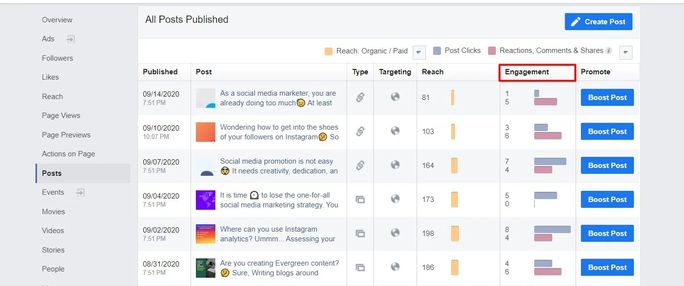
Another efficient way of accessing your engagement metrics is with SocialPilot’s Facebook analytics feature.

A tool like SocialPilot becomes a necessity rather than a mere option if you are someone managing multiple Facebook accounts.
It allows you to track the analytics of multiple Facebook accounts under one dashboard.
In addition to that, you can also monitor and export analytics of numerous social media platforms, such as Twitter, LinkedIn, Instagram, and Pinterest.
Yes, you heard that right! The exports feature lets you download or share the social analytics report directly from the tool with multiple email ids.
Do you dread the task of sharing social performance reports with clients periodically?
Don’t worry and leverage the “Schedule Report” feature of SocialPilot analytics to automate the sharing of your reports on a specific day of the week or the first of every month with clients. Say goodbye to the turmoil of generating social media reports manually every month.
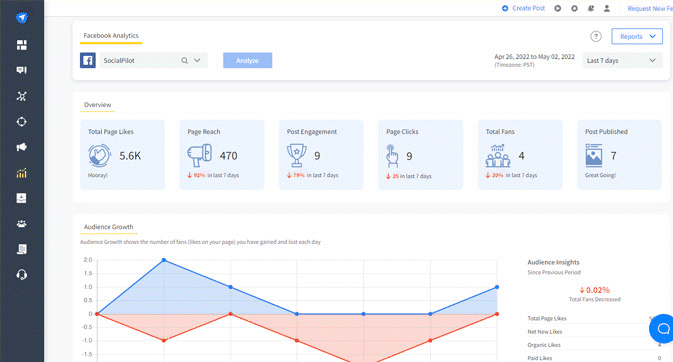
Why is the engagement metric an important Facebook KPI?
The engagement metric is the most crucial factor to indicate your content’s worth on social media.
More people engaging with your posts is the evidence that your content is resonating with your users. So using this metric, you can figure out which form of content is working for you and which isn’t.
But that’s not all.
Good engagement also gives you an advantage in the eyes of the Facebook algorithm. Once the algorithm detects that users find your content interesting, it will show more of your content in their feed.
2. Reach
Reach tells you the number of people who have seen your content on Facebook. It is quite a vague number compared to engagement but still keeps you informed about your potential audience size.
Where can you track it?
Like engagement, you can see your individual post’s reach (organic and paid) in the Facebook insights under the “Post” section.

Also, to compare your post’s reach over time, you get a graphical representation of all your posts in the “Reach” section of the Facebook Insights page.
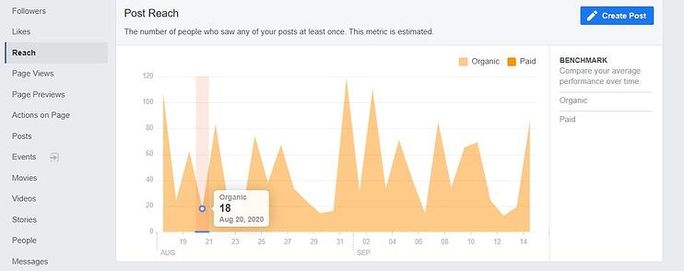
SocialPilot also gives you a clear look at the reach of every post.
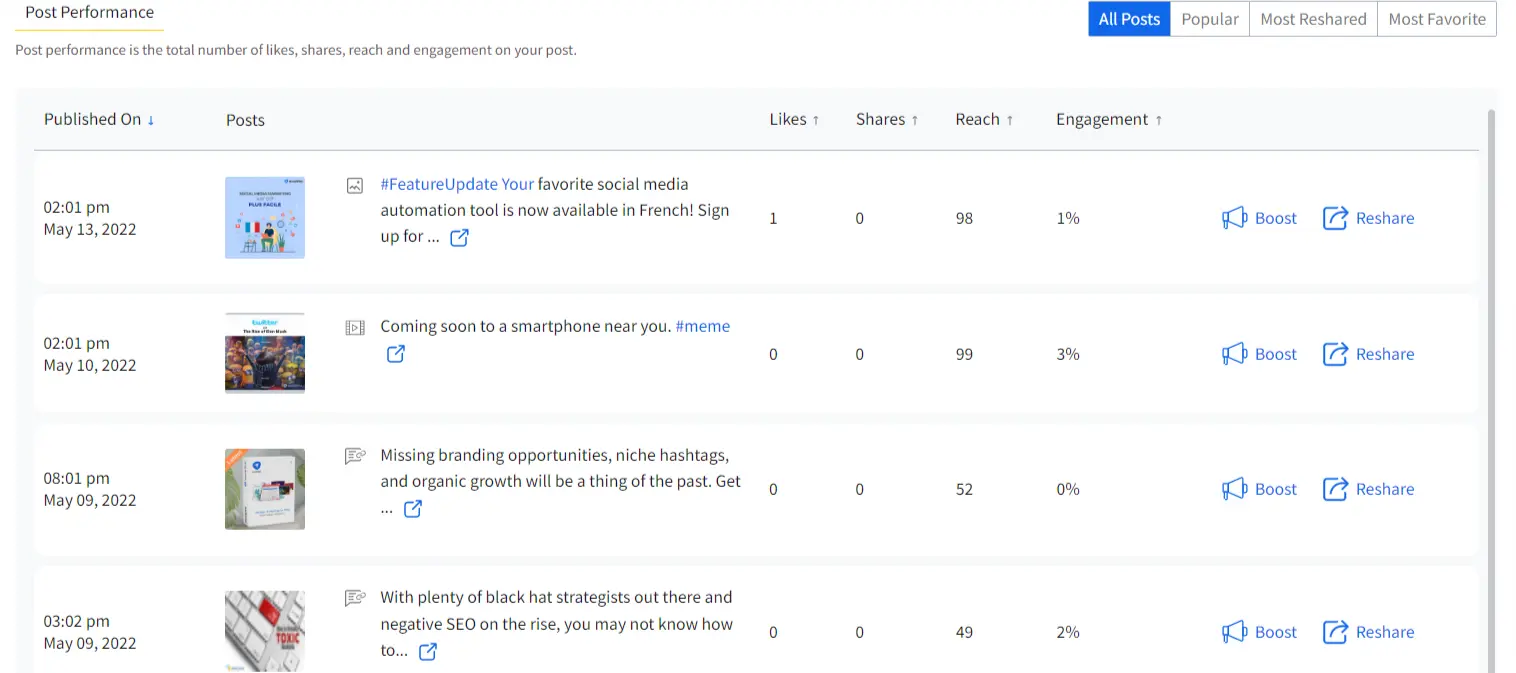
Why is the reach metric an important Facebook KPI?
If your business has just seen the social media world’s light, then ‘reach’ can be the most vital metric to assess your brand awareness.
But here’s a piece of bad news.
Organic reach on Facebook is at an all-time low since 2012, so if you are looking to increase your reach drastically on the platform, you need to resort to Facebook ads for the needed boost.
Still, there is a bright side!
By analyzing your reach metrics, you will see which post of your account is getting more organic reach, so you can further boost it to tenfold the number.
Productivity tip:Use SocialPilot to schedule and boost your top-notch posts for multiple Facebook pages in one-click.
Another reason to analyze and strive for good reach is that it directly affects your engagement metrics. The more reach a post has, the better are its chances to get good engagement.
3. Impressions
Reach and impression are somewhat the same with a subtle distinction.
What is it?
Reach gets counts for every unique person seeing your posts.
Whereas, impressions count the number of times someone has seen your posts, no matter if it’s the same person watching it again and again.
For example, if someone sees your post on the feed and again encounters it as a shared post from someone, it will be counted as 2 impressions but 1 reach.
How to track impressions?
You will find the impression garnered over your individual post by tracing the same path as you did for engagement and reach – on the Facebook insights inside the “Post” section.

Why is the impression metric an important Facebook KPI?
The impression metric is an excellent way to find out the virality of a post. But keep in mind that not every post with an impression is a viral post.
Your impression count will always be equal or higher to your reach. But to define that a post is viral among your users, you need to have a larger number at the side of your impression.
Did you know that impression can also lead to conversion?
According to the “marketing rule of seven,” your prospects have to come across your post at an average of 7 times before taking any action.
Thereby, having more impressions on your posts can lead to having more conversion. So keep track of the posts that have substantial impressions and try to make more of such content in your Facebook ad campaigns.
4. When your fans are online
This section tells you about the presence of your audience on Facebook across the week. Its graphical representation shows you, on average, how many of your fans are online on a day or week at a specific time.
Where can you track it?
You will find this section on top of the “Post” tab, under the Page Insights.
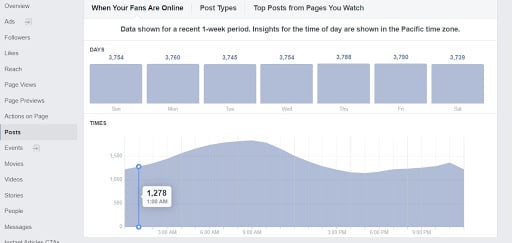
SocialPilot also tells you about the number of fans active on Facebook at each hour of the day.

Why is “When your fans are online” metric an important Facebook KPI?
With organic reach on a steep decline since 2012, using the best time to post on Facebook is the only way to cut through the noise and get some eyes on your content without using paid-ads.
But here’s the catch, every business has a different best time.
Enters the “When your fans are online” section!
This section briefly tells you the time when most of your fans are online to connect with your Facebook post.
What does this mean for you?
It means you can publish your posts on days and hours, showing the most fans online to get more reach and engagement.
Facebook Audience Metrics
Facebook audience metrics give you an in-depth insight into the age, gender, location, and language of your followers, fans, and the people that you have reached.
5. Age and gender demographics
The age and gender demographics metrics are a great way to zero down on your relevant audience. This section gives a graphical representation of your fans and followers grouped by age and gender.
Where to track it?
You can easily track the age and gender metrics on your Facebook Insights page under the “People” section.
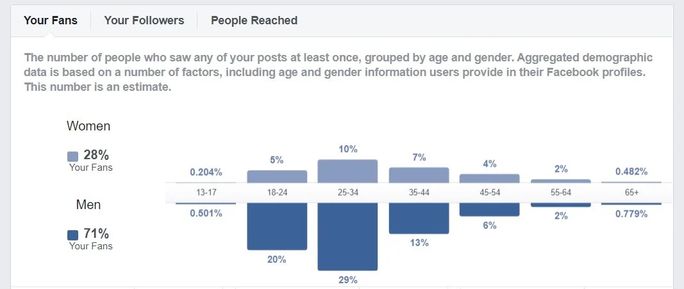
Alternatively, you can also check your audience demographics on SocialPilot’s Facebook analytic page.
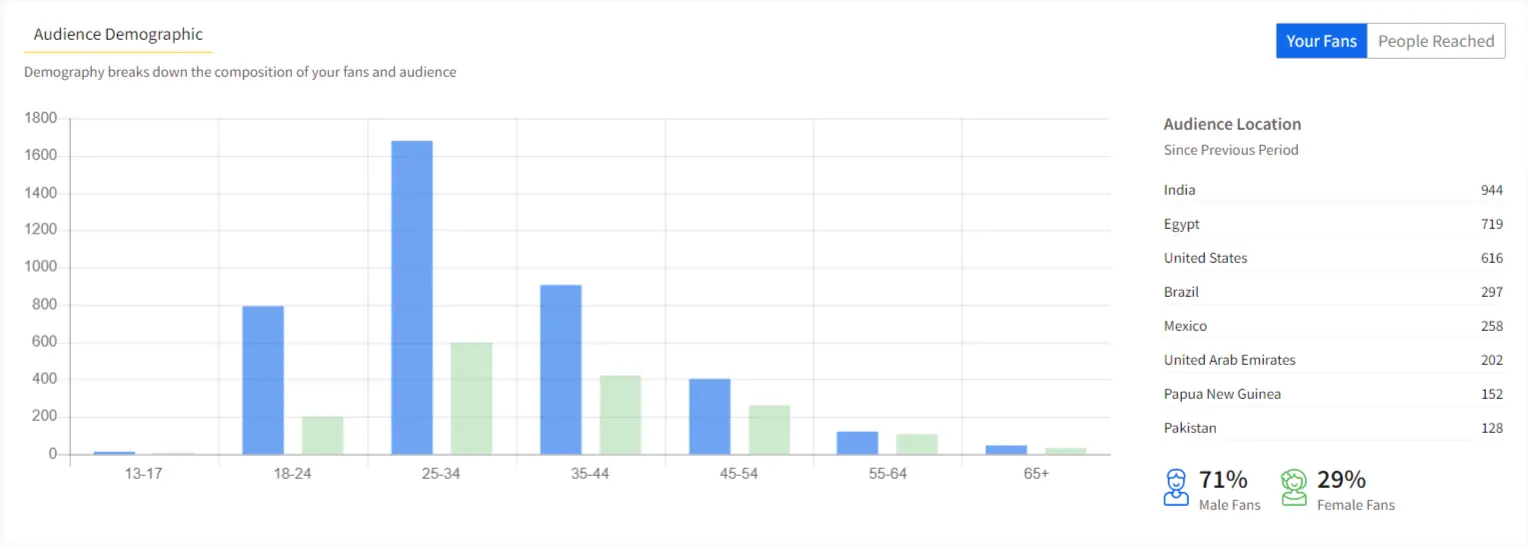
Why are age and gender metrics an important Facebook KPI?
Imagine a business that sells canes for older people creates a Facebook post using Gen-Z lingo. Surely, it would not go down with good engagement.
That is why you need a better understanding of your target audience for creating a solid Facebook content strategy.
Simply put, looking at your follower’s breakdown based on age and gender helps you set a more holistic content marketing strategy.
So dive down into your age and gender metrics to find out your relevant audience and create content that caters to that lot.
6. Location and language metrics
As an elongation of age and gender metrics, this section helps you get insights into the location and language of your fans and followers.
Where to track it?
You will get this data in a tabular form right below the age and gender metrics.
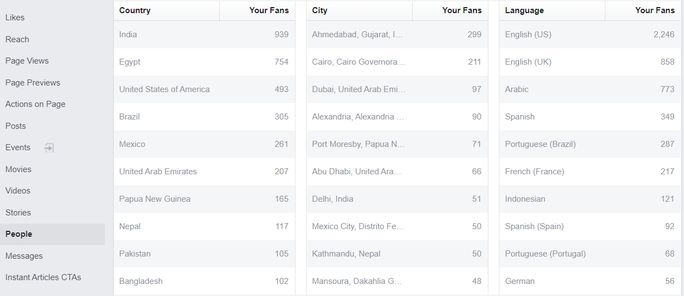
Why should you track the “Location and language” metric?
If you are a brand catering to locations worldwide, then it is for sure that your one-size-fits-all content approach won’t work on everyone.
What’s the solution?
It would be best to opt for a content localization strategy that suits your target audience’s linguistic nuances, cultural and social factors, aesthetic choices, and even political and religious norms.
Luckily you can get a clear idea of your Facebook audience’s location and language preferences using the audience insights and mould your content accordingly.
Productivity tip: Use the Facebook audience targeting feature to show your post in the news feed of a specific segment of people based on their location and language.
Facebook Traffic Metrics
This category tells you the amount of traffic being driven to your website and Facebook page.
7. Facebook referral traffic
Facebook referral traffic metrics tell you about the amount of traffic coming to your website from your Facebook page. This traffic can be coming from visitors clicking on your profile, posts, and shared posts.
Where can you track it?
Google Analytics shows you all the data around your referral traffic. Make sure that you already have a Google Analytics account set up.
To access this data, click on the “Acquisition” from the left-hand menu in Google analytics, and then go to Social>Network Referrals. Here you will see the traffic your website is getting from all your social media networks. Find Facebook in it.

Why is it important to track Facebook referral traffic metric?
For every business, it’s essential to evaluate whether their content on Facebook is pulling enough people back to their website or not.
Facebook referral metric helps you keep track of Facebook-to-website visitors. It gives you a holistic look into the number of sessions on your website, how many pages were viewed, and how long the user stayed on your site.
Overall it tells you how compelling your content or headlines were that people clicked on it and cruised inside your site.
So, if you see the referral traffic declining, it means that people are not finding your content effective enough to click.
8. Facebook page traffic
This metric indicates the amount of traffic coming to your Facebook profile page from different sources present on the internet, including Facebook feed.
Where to track this metric?
To track this metric, go to the “Page Views” section of insights and find a graphical representation of top sources sending out traffic to your page.
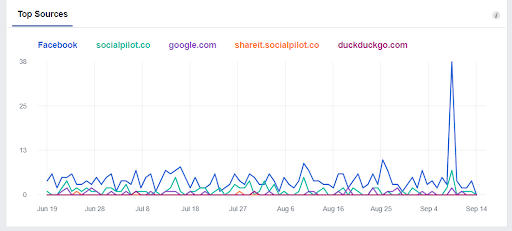
Why should you track the Facebook page traffic?
Just like you’d check your Facebook referral traffic, keep track of the number of traffic coming from your websites to your Facebook profile too.
As a new business, it’s essential to have a well-integrated social media and website connection to maximize your exposure. So whenever organic traffic comes to your website, it also gets attracted to your social profiles.
It also tells you about the number of people who saw your website, product, or service and decide to hold on for longer by coming on your Facebook page.
Facebook Page Metrics
Facebook page metrics informs about the number of likes and follows on your page.
9. Page likes and follows
As the names suggest, page likes are the number of people who liked your page to support and followed it to see your content on their feed.
But there’s a thin distinction between page likes and follows.
When someone likes your page, it gets followed automatically. However, they can opt to unfollow it, so they don’t receive any further updates from your page. Still, these people will be shown as your audience.
On the other hand.
If they unlike your page yet still follow it, they will be counted as your lookalike audience but not as your audience.
Where to track them?
To track the in-depth insights around your page likes, go to the “Likes” section under the Page Insights.
Here you will see the breakdown of your organic and paid likes, as well as the number of unlikes you have got over the time of your chosen period.
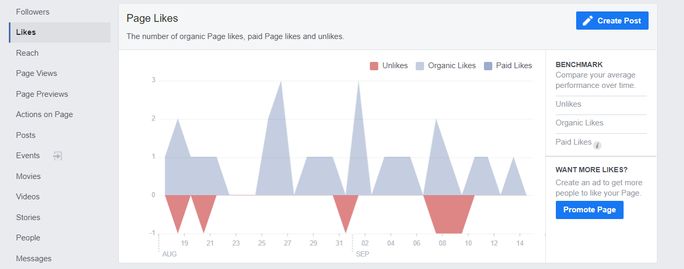
And if you are looking to track your page follows,
Go to the “Followers” section to get the breakdown of your organic, paid followers, as well as the people who unfollowed you during the time of your chosen period.
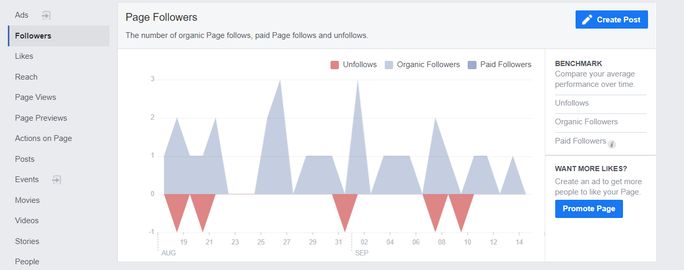
SocialPilot also tells you the number of page likes you have lost and gained each day.

Why should you measure the page likes and follows metric?
It’s true that page likes and follows are a vanity metric when compared to the engagement metric.
But still, as a new business page, it gives you a fair idea of your audience reach and your growth rate on Facebook.
Anyways, increasing followers is a far better sign for your business than stagnant follower numbers. If you see your follower’s growth declining or not growing month by month, there is something off with your Facebook marketing.
Facebook Ad Metrics
Facebook ads manager gives you tons of metrics to monitor your ad campaign. But the sheer amount of data can be overwhelming for anyone.
So the trick to get the most out of your Facebook ad metrics is to keep your marketing goal in sight while evaluating them.
Here, we have touched briefly on some of the most common ad metrics that every business needs to track.
Where to track them?
You will get every metric related to your ad performance inside the Facebook ads manager.
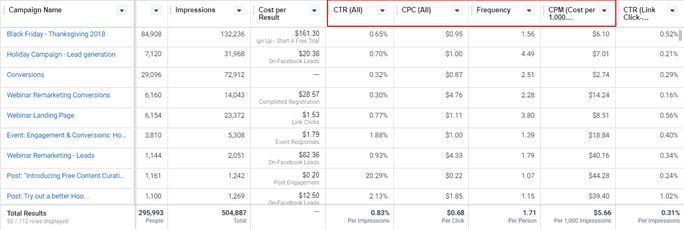
Let’s see some of the most common metrics that can be of high value to you, depending on your campaign goals.
10. CTR
Click-through rate (CTR) metrics show you the percentage of people coming on your landing page after clicking through your ad.
Why is the CTR an important Facebook metric?
CTR is one of the most crucial metrics to evaluate your ad campaign’s effectiveness. It gives you an overall view of your ad’s performance in attracting users.
A good CTR tells you that your ad is of quality and has an excellent relevant score too. So if your CTR is hitting rock bottom, then make some changes in your ad copy and try to make it more relevant for your targeted users.
11. CPC & CPM
So on what basis do your Facebook ads get charged?
Facebook ads manager gives you multiple options to be charged, and two of them are cost-per-click (CPC) and cost-per-thousand-impressions (CPM).
CPC metrics tell you how much you are paying when someone clicks on your ad, and CPM shows how much you are paying for every thousand impressions on your ad.
Why should you track these metrics?
Both CPC and CPM align with your objective to create better reach and brand awareness on Facebook.
Instead of monitoring your whole budget, it will be more informative if you peek at these two metrics to evaluate the worth of your spending.
12. Ad Frequency
Ad frequency refers to the average number of times your targeted audience sees a specific ad on their Facebook feed.
For example, your ad frequency will be 4, if your ad is seen by the average targeted audience 4 times.
Why should you track this metric?
You might be thinking, the more the frequency, the better.
Well, no. According to ad espresso’s report, as the ad frequency increases, it decreases the CTR and gives a hike to your average CPC.
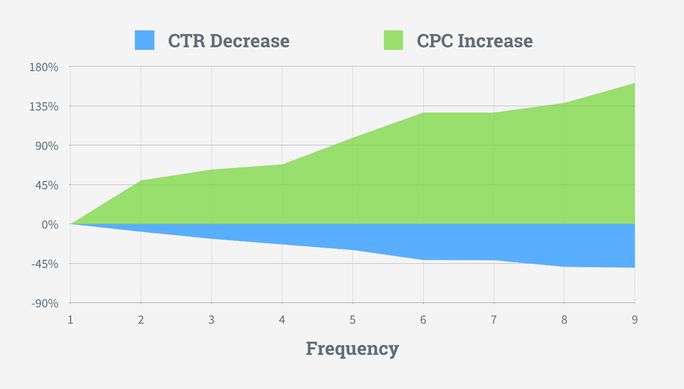
But then again, I have told you about the rule of seven, where a person must come across your ad seven times to be interested in making a decision.
See, the escape from this dilemma is to create the same ad but with multiple variations. Tweak the visuals and copy of your ad so that it doesn’t become boring for your audience and lose its impact over time.
Okay, we are done with all the Facebook metrics that could help assess your performance to make better Facebook marketing decisions.
Let’s quickly summarize them.
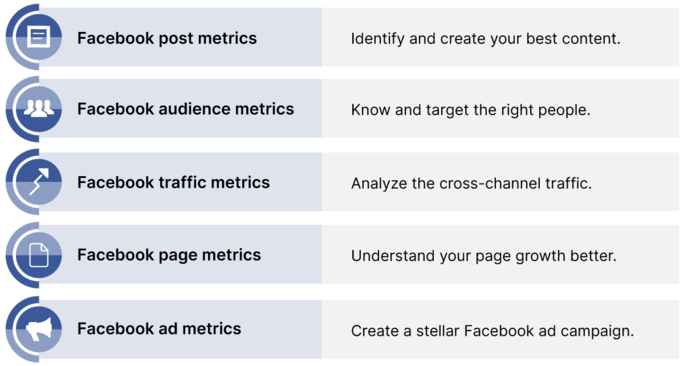
So, which metrics are you going to track?
Facebook provides a plethora of metrics to measure and maintain your account’s performance steadily. Choosing the metrics which matter the most to you totally depends on your marketing goal.
We hope this blog gives you a reference point to start evaluating your key Facebook metrics.
Also, don’t hesitate to use a fantastic analytics tool like SocialPilot to analyze multiple Facebook page metrics under one dashboard. It will save you a lot of time.
Happy assessing!
[ad_2]
Source link






More Stories
Prior Authorization, The Initial Step To Holistic Revenue Cycle Management
3 Key Components to Effective Time Management
Challenges to Gamifying Project Management